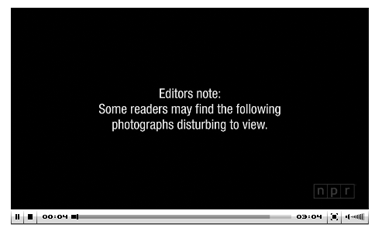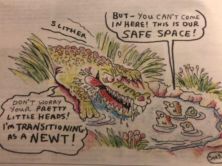
A screen capture from NPR slide show of images from Haiti.
Conflicting loyalties of medical correspondents aren’t the only ethical minefield for media reporting on this January’s devastating earthquake in Haiti. Would American media run the same graphic images showing piles of corpses of US citizens?
Questions have also sprung up over graphic images of the disaster published by a range of media including the New York Times, Washington Post, the Associated Press and on the website of National Public Radio.
On February 1, NPR’s Talk of the Nation opened a discussion on ethical photojournalism and the images from Haiti.
Talking with NPR photographer David Gilkey, visual journalism and ethics expert Kenneth Irby, and Washington Post ombudsman Andrew Alexander, host Neal Conan says,
After natural disasters like the quake in Haiti, among human conflict like Iraq or Rwanda or even after a bloody car accident, editors struggle. Will this picture offend the dignity of victims? Will it offend viewers? If we don’t show it, are we sanitizing an ugly reality that people need to see?
Where should the news media draw the line?
According to Andrew Alexander, “The news industry has no universally accepted rules on use of disturbing images.”
Alexander tells Conan the Washington Post gave a lot of thought to their use and placement of graphic images of death. Many readers of both the Washington Post and the New York Times questioned whether the media is more inclined to publish graphic images of the dead when those victims are dark-skinned. In a column on the subject, Alexander writes that he asked Post editors if they would have likely published similar images if the earthquake had happened not in Haiti but in a place like Sweden.
He says to Conan “Their answer was that they thought that it would be treated the same. I think scale is important, and I have to believe that probably in a situation like that, I think they would have treated it the same.”
In a similar post at the New York Times on January 23, public editor Clark Hoyt explains that he asked the same question of Michele McNally, an assistant managing editor in charge of photography at the Times. “If such pictures existed, she said, she would run them,” he writes.
NPR, a radio network was not itself immune. NPR’s website published images from Haiti. On the Feb 1 Talk of the Nation broadcast, NPR staff photographer David Gilkey argues images that represent the reality of the situation in Haiti, however graphic, are necessary to communicate the scale of the disaster to people:
I mean, you’re talking about thousands of bodies, and somehow it might be a cliché, but that is something that really is a picture’s worth 1,000 words,” he tells Conan. “It just you had to show it. It was just on a scale that I’d never seen before, and I’ve traveled extensively in war zones and conflict areas and disaster zones, and I’d never seen anything like this.
Kenneth Irby, Director, Visual Journalism Group, Poynter Institute for Media Studies, tells Conan he also thinks similar photos would have been published after a Swedish disaster. But, he says, it “smacks of hypocrisy” that papers as a rule still hesitate to publish graphic photos of a dead body in their own town or city. “…Proximity, that leads us, that lends us to being in a position where we are inconsistent in the kinds of decisions that we make when photographs happen closer to us, and we feel a guiding principle or moral guideline that says that we have to be more sensitive to life,” he responds.
Describing the difficulty of deciding whether to run graphic images, Kirby explains the process as a balance between being truthful and minimizing harm. “I think the process that news organizations have to go through to make those decisions, as Andy alluded to, is that they’re thinking about how do we navigate that fine line between maximizing truth telling and minimizing harm,” he says on NPR.
The National Press Photographers Association puts it this way, “Treat all subjects with respect and dignity. Give special consideration to vulnerable subjects and compassion to victims of crime or tragedy. Intrude on private moments of grief only when the public has an overriding and justifiable need to see.”
In that balancing act, segments of the public are bound to be critical no matter what action a publisher ends up taking. Both Alexander and Hoyt write they have received letters from readers both condemning and appreciating difficult photos published in the wake of the Haitian earthquake but the percentages of “for versus against” are not transparent.
Only a formal US media survey of graphic images would objectively quantify, and thus answer the question: If, in fact, Americans or people of color are treated, by percentages, the same way as the foreign, dark-skinned “other.”





